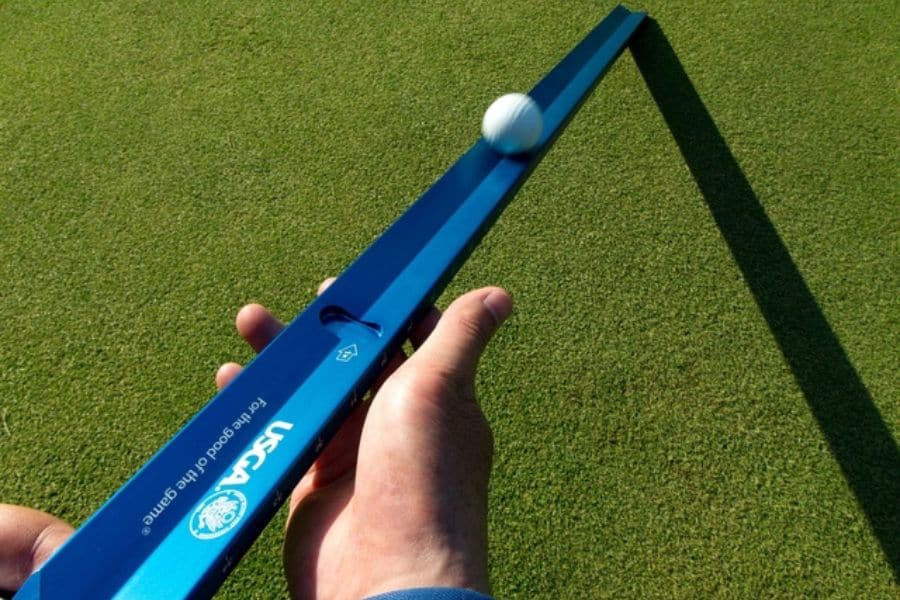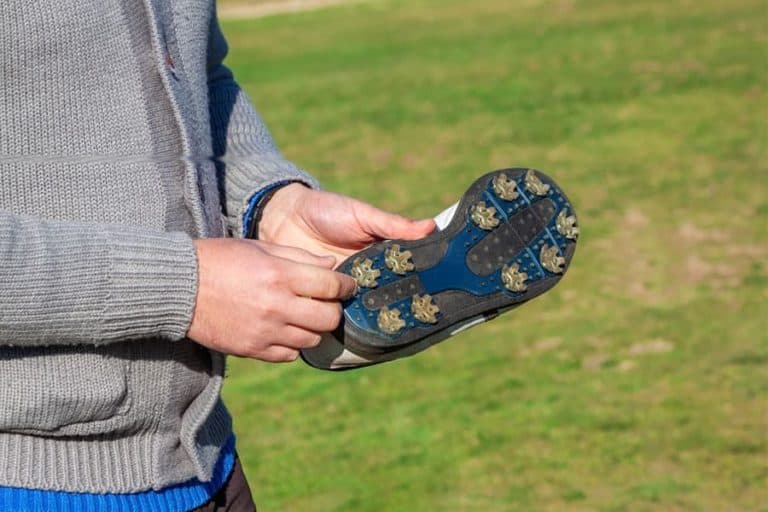What Is A Stimpmeter And How Does It Work?

Learn about the iconic Stimpmeter, a tool for measuring green speed on courses. We’ll examine how it works and has impacted course maintenance and design.
If you’ve ever watched professional golf on television, you may have heard the term “Stimpmeter” mentioned by commentators and tour players. The Stimpmeter is an essential tool for golf course greenkeepers for measuring green speed and enhancing maintenance and design.
We will examine how this simple yet effective device measures the speed of the greens and how it has helped shape golf course maintenance and design over the years.
What is a Stimpmeter?
The Stimpmeter is a simple and crucial tool used in golf course maintenance to measure the speed of putting greens accurately.
It is a three-foot-long extruded aluminum bar with a V-shaped groove that runs its entire length. A ball is placed approximately 30 inches from the tapered end that rests on the ground.
The Stimpmeter applies a gravitational velocity to the ball, and the distance traveled provides a green-speed reading. Without the Stimpmeter, groundskeepers would have difficulty measuring green speeds accurately, resulting in consistent greens that can impact the game and players’ performance.
By carrying out Stimpmeter readings, groundskeepers can make necessary adjustments to ensure the greens are consistent.
History of Stimpmeter
The Stimpmeter was invented by golfer Edward S. Stimpson, Sr., in 1935. He was a spectator at the 1935 U.S. Open at Oakmont.
While watching the U.S. Open, Stimpson witnessed a putt by Gene Sarazen, a top professional golfer, roll off a green. He wanted to prove that the greens were unreasonably fast. That is when he decided to design a device that could measure green speeds. He designed a device made of wood, which is now known as the Stimpmeter.
The device is an angled track that releases a ball at a known velocity, allowing the distance it rolls on a putting surface to be measured.
In 1976, Frank Thomas of the United States Golf Association (USGA) redesigned Stimpson’s Stimpmeter and painted it green. The redesigned Stimpmeter was first used in the 1976 U.S. Open in Atlanta. Later in 1978, it was made available to golf course superintendents.
In 2012, the USGA announced a third-generation device based on the work of Steven Quintavalla, a senior research engineer at the USGA labs.
This version has a second hole that enables the option of a shorter run-out, is painted blue, and is manufactured to a higher engineering tolerance to improve accuracy and precision.
How does a Stimpmeter work?
A Stimpmeter is a simple tool to use. However, to use a Stimpmeter, you need the following equipment:
- Stimpmeter
- Three tees
- Three balls
- 12 or 15-foot measuring tape
- Data sheet
Here is how to use a Stimpmeter effectively:
Step 1
Find a flat piece of putting green on the course several feet wide and approximately 10 to 12 feet long.
Step 2
Place a tee at one end of the green to indicate the starting point and hold the device by the notched end.
Place the golf ball and lift the end gradually until it reaches an angle of about 22 degrees, allowing the ball to roll down. Repeat the procedure with two more balls while keeping the tapered end on the same spot.
Step 3
Ideally, all three balls should come to rest within 8 inches of each other. If they are farther apart, it could be because Stimpmeter may have moved during the series, or the balls may be damaged.
In such cases, repeat the process. However, if the balls stop within the 8-inch limit, a second tee should be inserted at their average stopping point to measure the length of the first series of rolls.
Step 4
Roll three balls in the opposite direction along the same line by using the second tee as a starting point and the first tee as an aiming point, and repeat the process of Step 2.
Step 5
Repeat Step 3 to determine the length of the second series of rolls. Measure both distances, and calculate the average to obtain the speed of the green.
Step 6
Record the reading on a data sheet for future reference, and adjust the green’s speed accordingly to ensure consistency.
How does one interpret the readings?
Stimpmeter readings can vary depending on the factors that affect green speed, such as weather conditions, grass type, and maintenance practices. In general, green speeds that are too fast or too slow can significantly impact putting difficulty.
A consistent Stimpmeter reading across all their greens is typically desirable for golf clubs, and the ideal speed for club golfers is around 9 or 10. This speed provides a reasonable level of challenge without being excessively difficult.
For professional tournaments, greens are typically made slicker and faster, and Stimpmeter readings can reach 13 or more. However, the appropriate green speed for a particular course depends on various factors, such as the contours of the greens and their exposure to wind.
What is a good Stimpmeter reading?
Golf courses usually aim for a Stimpmeter reading of 9 or 10. This range is considered the average green speed that is not too fast or too slow greens.
During golf tournaments, it is common to see higher Stimpmeter readings of 11 or 12, the average on the PGA Tour. Moreover, some courses even have greens that can reach speeds of 13, 14, or 15, making it incredibly challenging for even the most skilled golfers.
Is 11 on Stimpmeter fast?
For an average golfer, a Stimpmeter reading of 11 would be considered quite fast and could present a significant challenge on the green. Professional golfers, on the other hand, are accustomed to playing on greens at such speeds.
However, for the average golfer, anything above a Stimpmeter reading of 9 or 10 may require some putting technique and strategy adjustments.
How fast is 13 on the Stimpmeter?
A Stimpmeter reading of 13 is considered extremely fast and challenging for even professional golfers. It requires a very delicate touch and precise putting technique to navigate the green successfully.
What is the highest Stimpmeter rating ever?
Oakmont Country Club holds the record for the highest Stimp reading ever recorded, with a reading of 15 feet. The course is renowned for having some of the fastest greens in the world.
How fast are the masters greens?
Augusta National, home of the Masters, does not disclose or allow any formal stimp readings of their greens because each hole has its unique design and character.
The speed of the greens is intentionally varied to add to the challenge of the course, and the grounds crew knows how fast each green should be. However, it is believed that greens at Augusta run at an average of 12 on the stimp, peaking as high as 15.
What is the ideal Stimpmeter reading for an office putting green?
The ideal Stimpmeter reading for an office putting set depends on personal preference and the intended use of the green. However, generally, a Stimpmeter reading of around 8 to 10 feet would be suitable for office putting sets.
How to make a Stimpmeter For Measuring Green Speed?
While it is possible to purchase a Stimpmeter, you may not find many options online. However, you can simply make one yourself with a few simple materials. Here are the steps to make a Stimpmeter DIY:
- Get a metal ruler or a long, straight piece of metal that is at least 36 inches long.
- Find a flat, level surface to test your Stimpmeter.
- Tape the ruler or metal strip to the surface to stick out over the edge. Make sure it is securely attached and leveled.
- Place a golf ball at the end of the ruler or metal strip farthest from the surface and release it. Measure the distance the ball rolls on the flat surface.
- Repeat the process two more times from the same starting point, and then calculate the average distance rolled by the ball.
- This average distance is your Stimp reading.
Conclusion
While there are a few changes in the original Stimpmeter design, there are no significant changes. The device has given groundkeepers a reliable way of measuring green speeds, resulting in a fair playing field for golfers around the world.








